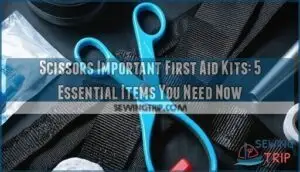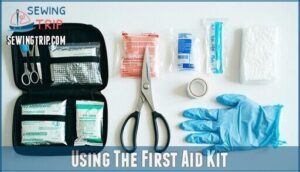This site is supported by our readers. We may earn a commission, at no cost to you, if you purchase through links.

When someone’s injured and their clothes are stuck to a wound, you can’t just yank fabric away—you need to cut it carefully.
Quality medical scissors slice through bandages, tape, clothing, and even seatbelts during emergencies.
They’re your go-between when seconds count and precision matters.
Don’t grab kitchen shears; proper first aid scissors have blunt tips to prevent accidental cuts and serrated edges for tough materials.
Whether you’re dealing with a camping accident or kitchen mishap, having the right cutting tool transforms chaos into control.
The other four essential items work hand-in-hand with your scissors.
Table Of Contents
Key Takeaways
- You’ll need medical scissors more than you think – they’re essential for cutting through clothing, bandages, and even seatbelts during emergencies without causing additional injury
- Don’t use kitchen shears – proper first aid scissors have blunt tips to prevent accidental cuts and serrated edges to handle tough materials safely
- Stock your kit with five core items that work together: disposable gloves, sterile gauze pads, adhesive bandages, antiseptic wipes, and trauma shears
- You’ll be useless in an emergency if you don’t know how to use your supplies – practice proper techniques and keep your kit accessible with current, unexpired items
Types of First Aid Scissors
When emergencies strike, you’ll need the right scissors to handle various cutting tasks safely and efficiently. Bandage scissors feature one blunt tip and one sharp tip, allowing you to cut dressings and tape without accidentally nicking skin.
The right scissors can be the difference between help and harm in an emergency.
Trauma shears pack serious cutting power with angled blades that slice through tough materials like denim, leather, or seatbelts during rescue situations.
Medical scissors come in several specialized forms. Fine-point surgical scissors offer precision for delicate work, while rounded tips provide extra safety when working near sensitive areas.
Utility scissors handle general cutting tasks, and compact folding scissors save space in portable kits.
EMT scissors and first aid kit scissors vary in size and strength. Choose trauma shears for heavy-duty emergencies and bandage scissors for routine wound care.
Having multiple types guarantees you’re prepared for any situation. Trauma shears are also useful as field-ready tools in a variety of emergency scenarios.
The Five Most Important Items for a First Aid Kit
When preparing for unexpected situations, having the right medical supplies can make all the difference. Your first aid kit should contain these five essential items that work together to handle most emergency situations effectively.
These core components form the foundation of any reliable first aid kit:
- Disposable gloves – Protect yourself from bloodborne pathogens during wound care
- Sterile gauze pads – Control bleeding and dress wounds in various sizes (4×4 inches recommended)
- Adhesive bandages – Cover minor cuts and scrapes with flexible fabric varieties
- Antiseptic wipes – Clean wounds before applying dressings to prevent infection
- Trauma shears – Cut through clothing quickly to access injuries during emergencies
These scissors first aid tools complement other medical supplies like Essential Medications, CPR Mask, and Burn Treatment items. Quality wound cleaning supplies and proper Splinting Materials enhance your kit’s effectiveness.
Remember, over 85% of home first aid kits include sterile gauze, while 84% contain antiseptic supplies for wound care. It’s also important to have emergency phone numbers readily available. These five items prepare you to handle basic medical emergencies until professional help arrives.
Using The First Aid Kit
Preparation matters when seconds count. Having your first aid kit within arm’s reach won’t help if you don’t know how to use it properly. Scene safety comes first—assess the situation before diving in.
Emergency readiness means nothing without the knowledge to act when it matters most.
Kit accessibility means storing supplies where you can grab them quickly, not buried in a closet. Always wear gloves** before touching any wound to protect both you and the injured person. A vital addition to any kit is ensuring you have sharp fabric scissors for various cutting needs.
| Step | Action | Key Tool |
|---|---|---|
| 1 | Assess scene safety | Your eyes and brain |
| 2 | Put on protective gloves | Disposable gloves |
| 3 | Cut away clothing | Trauma scissors |
Supply management keeps your emergency kit functional. Check expiration dates regularly and restock used items immediately. During injury assessment, use scissors to expose wounds by cutting clothing rather than removing it. This prevents unnecessary movement that could worsen injuries. Your first aid supplies work best when you’re calm and systematic—panic helps nobody. Proper use of these supplies is crucial, and regular checks ensure everything is in working order.
Frequently Asked Questions (FAQs)
Why are scissors important in a first aid kit?
Like a Swiss Army knife in your medical toolkit, scissors cut through barriers to save lives.
You’ll need them to remove clothing, trim bandages, and access wounds quickly during emergencies when every second counts.
What are the 10 most important items in a first aid kit?
You’ll want bandages, antiseptic wipes, medical scissors, adhesive tape, pain relievers, instant cold pack, thermometer, tweezers, sterile gauze pads, and disposable gloves for thorough emergency care coverage.
What are the scissors in a first aid kit called?
Think of scissors as your first aid kit’s Swiss Army knife – they’re the unsung heroes ready to tackle any cutting challenge.
You’ll find trauma shears, bandage scissors, and utility scissors in most kits, each designed for specific emergency tasks, making them a crucial part of your first aid kit.
What is the function of scissors in wound dressing?
You’ll use scissors to cut bandages to proper size, trim medical tape for secure placement, and remove old dressings without pulling or tearing skin during wound care.
How often should scissors be cleaned?
Sharp scissors are like loyal guardians—they’ll only protect you if you keep them clean.
After each use, you should sanitize your scissors with antiseptic wipes or alcohol to prevent contamination and maintain hygiene standards.
Can regular household scissors work instead?
Regular household scissors can work temporarily, but they’re not ideal for first aid.
They lack blunt tips for safety near skin, may not cut medical materials effectively, and aren’t designed for sterile environments like proper medical scissors.
What if scissors become dull during emergency?
Dull scissors during emergencies can turn you into a frustrated surgeon wielding butter knives.
Keep backup scissors in your kit, apply more pressure when cutting, or use alternative tools like keys or sturdy cards to tear materials if absolutely necessary, which can help prevent becoming a frustrated surgeon and make the process more efficient with backup scissors.
Should left-handed people need special scissors?
Left-handed people don’t necessarily need special scissors for first aid, but they’ll find ambidextrous or left-handed trauma shears more comfortable and efficient during emergencies when precision matters most.
How to prevent scissors from rusting?
Picture rusty scissors crumbling in your hands during an emergency.
Keep your scissors dry, clean them after use, and store them in protective cases.
Choose stainless steel models for superior rust resistance and longevity.
Conclusion
Building your first aid arsenal is like constructing a safety net – each item strengthens the whole.
You’ve learned how scissors important first aid kits truly are, alongside bandages, antiseptic, gauze, and pain relievers.
These five essentials work together to handle most emergencies you’ll face.
Don’t wait until disaster strikes to gather supplies, stock your kit today, keep it accessible, and check expiration dates regularly.
When crisis hits, you’ll have confidence knowing your scissors important first aid kits contain everything needed to help others heal.
- https://survivalfirstaidkits.com/pages/scissors-for-first-aid-kit
- https://medicalgearoutfitters.com/blogs/firstaid/bandage-scissors-and-trauma-shears-what-are-they-used-for
- https://survivalfirstaidkits.net.au/pages/types-of-scissors-for-first-aid-kits
- https://pmc.ncbi.nlm.nih.gov/articles/PMC9742271/
- https://www.brownhealth.org/be-well/12-key-items-first-aid-kits







